Virginia Woolf's 'The Mark on the Wall': Modernity's Challenges
VerifiedAdded on 2020/05/16
|6
|1587
|140
Essay
AI Summary
This essay examines Virginia Woolf's short story, 'The Mark on the Wall,' focusing on its depiction of the lack of progress in modernity, particularly concerning gender roles and societal expectations. The essay analyzes Woolf's use of the stream of consciousness technique to reveal the narrator's inner thoughts and the societal constraints placed upon women in a patriarchal society. It explores themes of uncertainty, the impact of World War I, and the limitations imposed by traditional gender roles, using the 'Whitaker's Almanack' metaphor to illustrate the dominance of male perspectives. The essay concludes by highlighting Woolf's feminist discourse and her critique of a morally hollow society, advocating for a reevaluation of societal values and a broader understanding of human experience. The analysis underscores Woolf's resistance to rigid social norms and her call for a more inclusive and equitable world.
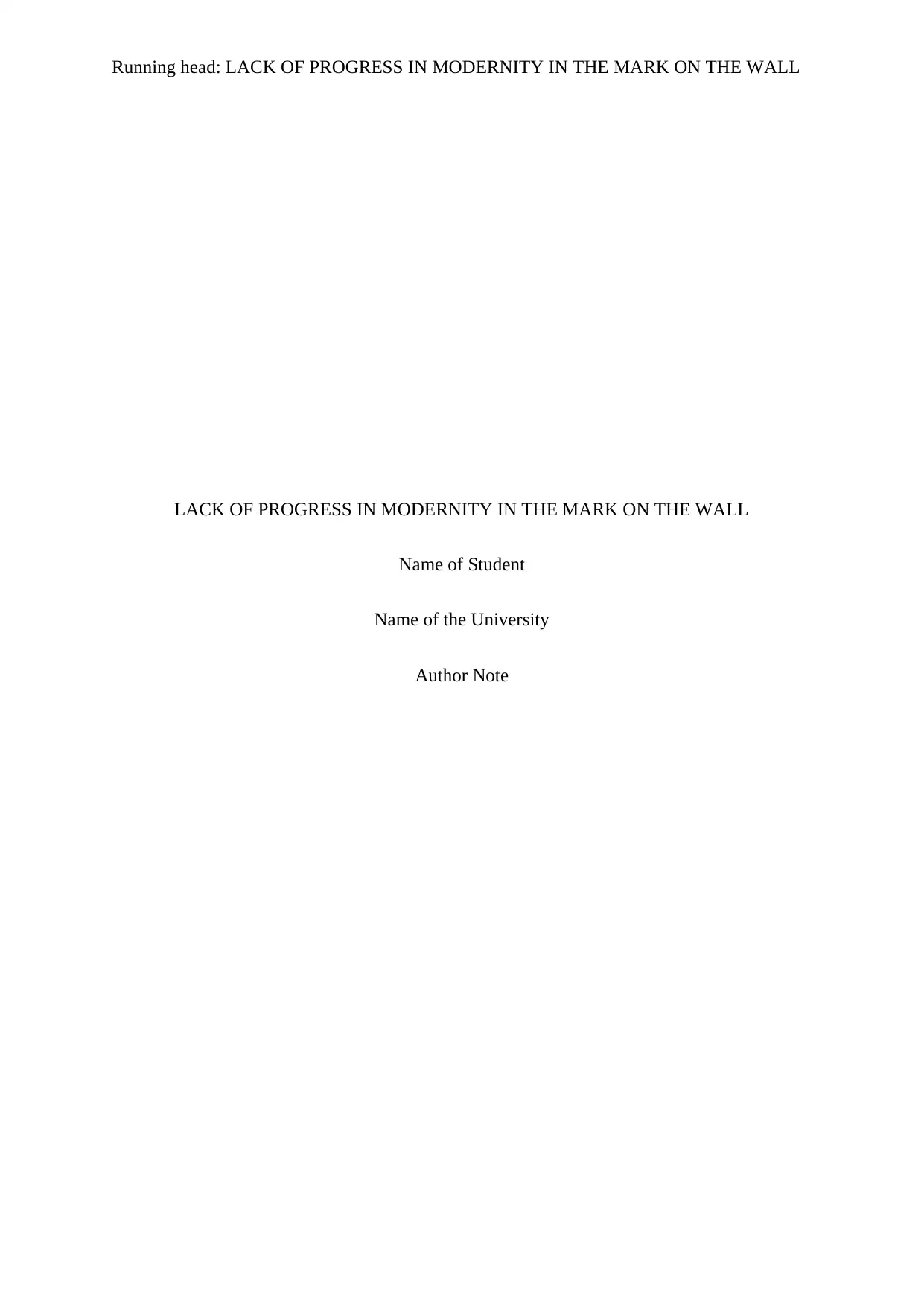
Running head: LACK OF PROGRESS IN MODERNITY IN THE MARK ON THE WALL
LACK OF PROGRESS IN MODERNITY IN THE MARK ON THE WALL
Name of Student
Name of the University
Author Note
LACK OF PROGRESS IN MODERNITY IN THE MARK ON THE WALL
Name of Student
Name of the University
Author Note
Paraphrase This Document
Need a fresh take? Get an instant paraphrase of this document with our AI Paraphraser
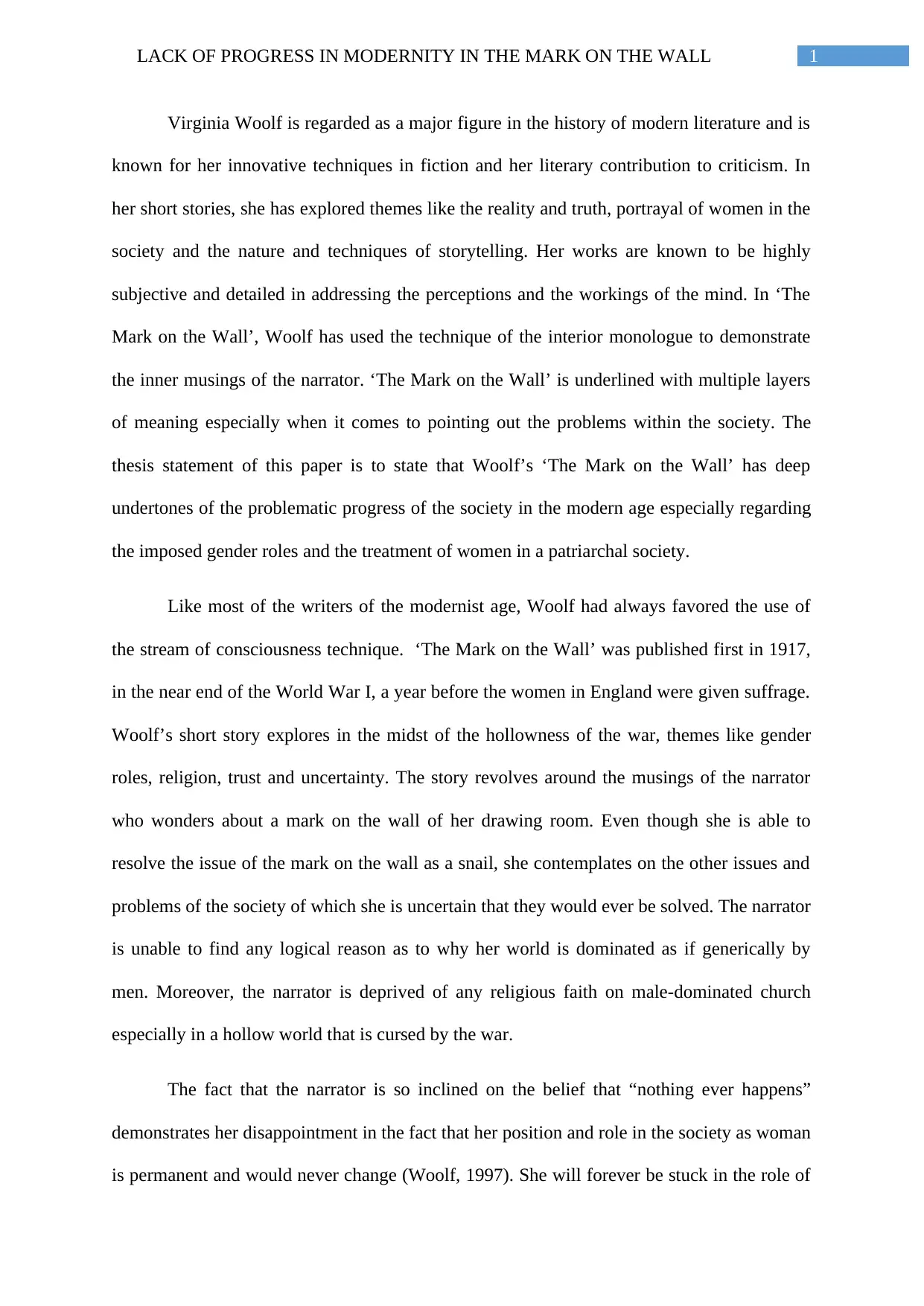
1LACK OF PROGRESS IN MODERNITY IN THE MARK ON THE WALL
Virginia Woolf is regarded as a major figure in the history of modern literature and is
known for her innovative techniques in fiction and her literary contribution to criticism. In
her short stories, she has explored themes like the reality and truth, portrayal of women in the
society and the nature and techniques of storytelling. Her works are known to be highly
subjective and detailed in addressing the perceptions and the workings of the mind. In ‘The
Mark on the Wall’, Woolf has used the technique of the interior monologue to demonstrate
the inner musings of the narrator. ‘The Mark on the Wall’ is underlined with multiple layers
of meaning especially when it comes to pointing out the problems within the society. The
thesis statement of this paper is to state that Woolf’s ‘The Mark on the Wall’ has deep
undertones of the problematic progress of the society in the modern age especially regarding
the imposed gender roles and the treatment of women in a patriarchal society.
Like most of the writers of the modernist age, Woolf had always favored the use of
the stream of consciousness technique. ‘The Mark on the Wall’ was published first in 1917,
in the near end of the World War I, a year before the women in England were given suffrage.
Woolf’s short story explores in the midst of the hollowness of the war, themes like gender
roles, religion, trust and uncertainty. The story revolves around the musings of the narrator
who wonders about a mark on the wall of her drawing room. Even though she is able to
resolve the issue of the mark on the wall as a snail, she contemplates on the other issues and
problems of the society of which she is uncertain that they would ever be solved. The narrator
is unable to find any logical reason as to why her world is dominated as if generically by
men. Moreover, the narrator is deprived of any religious faith on male-dominated church
especially in a hollow world that is cursed by the war.
The fact that the narrator is so inclined on the belief that “nothing ever happens”
demonstrates her disappointment in the fact that her position and role in the society as woman
is permanent and would never change (Woolf, 1997). She will forever be stuck in the role of
Virginia Woolf is regarded as a major figure in the history of modern literature and is
known for her innovative techniques in fiction and her literary contribution to criticism. In
her short stories, she has explored themes like the reality and truth, portrayal of women in the
society and the nature and techniques of storytelling. Her works are known to be highly
subjective and detailed in addressing the perceptions and the workings of the mind. In ‘The
Mark on the Wall’, Woolf has used the technique of the interior monologue to demonstrate
the inner musings of the narrator. ‘The Mark on the Wall’ is underlined with multiple layers
of meaning especially when it comes to pointing out the problems within the society. The
thesis statement of this paper is to state that Woolf’s ‘The Mark on the Wall’ has deep
undertones of the problematic progress of the society in the modern age especially regarding
the imposed gender roles and the treatment of women in a patriarchal society.
Like most of the writers of the modernist age, Woolf had always favored the use of
the stream of consciousness technique. ‘The Mark on the Wall’ was published first in 1917,
in the near end of the World War I, a year before the women in England were given suffrage.
Woolf’s short story explores in the midst of the hollowness of the war, themes like gender
roles, religion, trust and uncertainty. The story revolves around the musings of the narrator
who wonders about a mark on the wall of her drawing room. Even though she is able to
resolve the issue of the mark on the wall as a snail, she contemplates on the other issues and
problems of the society of which she is uncertain that they would ever be solved. The narrator
is unable to find any logical reason as to why her world is dominated as if generically by
men. Moreover, the narrator is deprived of any religious faith on male-dominated church
especially in a hollow world that is cursed by the war.
The fact that the narrator is so inclined on the belief that “nothing ever happens”
demonstrates her disappointment in the fact that her position and role in the society as woman
is permanent and would never change (Woolf, 1997). She will forever be stuck in the role of
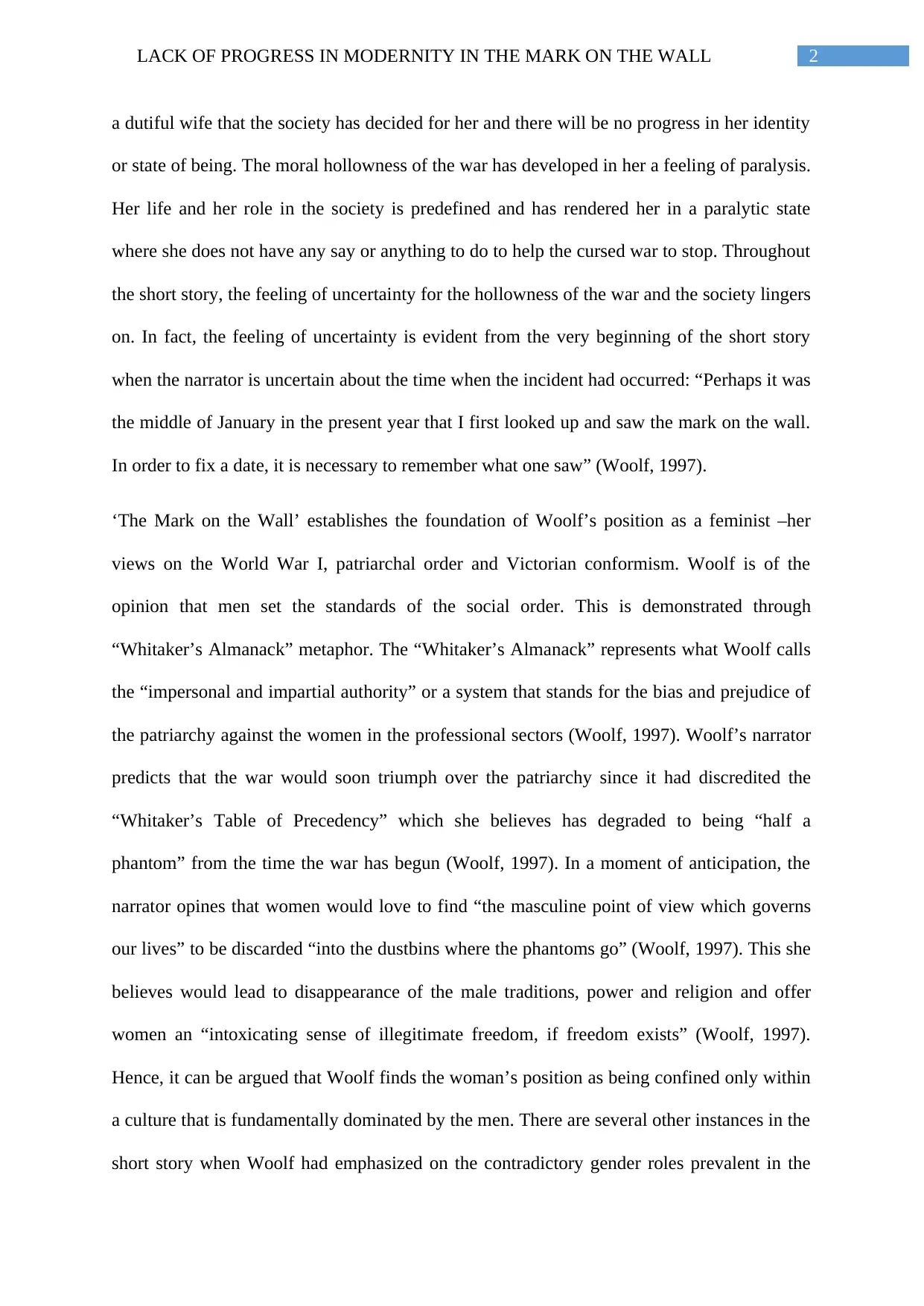
2LACK OF PROGRESS IN MODERNITY IN THE MARK ON THE WALL
a dutiful wife that the society has decided for her and there will be no progress in her identity
or state of being. The moral hollowness of the war has developed in her a feeling of paralysis.
Her life and her role in the society is predefined and has rendered her in a paralytic state
where she does not have any say or anything to do to help the cursed war to stop. Throughout
the short story, the feeling of uncertainty for the hollowness of the war and the society lingers
on. In fact, the feeling of uncertainty is evident from the very beginning of the short story
when the narrator is uncertain about the time when the incident had occurred: “Perhaps it was
the middle of January in the present year that I first looked up and saw the mark on the wall.
In order to fix a date, it is necessary to remember what one saw” (Woolf, 1997).
‘The Mark on the Wall’ establishes the foundation of Woolf’s position as a feminist –her
views on the World War I, patriarchal order and Victorian conformism. Woolf is of the
opinion that men set the standards of the social order. This is demonstrated through
“Whitaker’s Almanack” metaphor. The “Whitaker’s Almanack” represents what Woolf calls
the “impersonal and impartial authority” or a system that stands for the bias and prejudice of
the patriarchy against the women in the professional sectors (Woolf, 1997). Woolf’s narrator
predicts that the war would soon triumph over the patriarchy since it had discredited the
“Whitaker’s Table of Precedency” which she believes has degraded to being “half a
phantom” from the time the war has begun (Woolf, 1997). In a moment of anticipation, the
narrator opines that women would love to find “the masculine point of view which governs
our lives” to be discarded “into the dustbins where the phantoms go” (Woolf, 1997). This she
believes would lead to disappearance of the male traditions, power and religion and offer
women an “intoxicating sense of illegitimate freedom, if freedom exists” (Woolf, 1997).
Hence, it can be argued that Woolf finds the woman’s position as being confined only within
a culture that is fundamentally dominated by the men. There are several other instances in the
short story when Woolf had emphasized on the contradictory gender roles prevalent in the
a dutiful wife that the society has decided for her and there will be no progress in her identity
or state of being. The moral hollowness of the war has developed in her a feeling of paralysis.
Her life and her role in the society is predefined and has rendered her in a paralytic state
where she does not have any say or anything to do to help the cursed war to stop. Throughout
the short story, the feeling of uncertainty for the hollowness of the war and the society lingers
on. In fact, the feeling of uncertainty is evident from the very beginning of the short story
when the narrator is uncertain about the time when the incident had occurred: “Perhaps it was
the middle of January in the present year that I first looked up and saw the mark on the wall.
In order to fix a date, it is necessary to remember what one saw” (Woolf, 1997).
‘The Mark on the Wall’ establishes the foundation of Woolf’s position as a feminist –her
views on the World War I, patriarchal order and Victorian conformism. Woolf is of the
opinion that men set the standards of the social order. This is demonstrated through
“Whitaker’s Almanack” metaphor. The “Whitaker’s Almanack” represents what Woolf calls
the “impersonal and impartial authority” or a system that stands for the bias and prejudice of
the patriarchy against the women in the professional sectors (Woolf, 1997). Woolf’s narrator
predicts that the war would soon triumph over the patriarchy since it had discredited the
“Whitaker’s Table of Precedency” which she believes has degraded to being “half a
phantom” from the time the war has begun (Woolf, 1997). In a moment of anticipation, the
narrator opines that women would love to find “the masculine point of view which governs
our lives” to be discarded “into the dustbins where the phantoms go” (Woolf, 1997). This she
believes would lead to disappearance of the male traditions, power and religion and offer
women an “intoxicating sense of illegitimate freedom, if freedom exists” (Woolf, 1997).
Hence, it can be argued that Woolf finds the woman’s position as being confined only within
a culture that is fundamentally dominated by the men. There are several other instances in the
short story when Woolf had emphasized on the contradictory gender roles prevalent in the
⊘ This is a preview!⊘
Do you want full access?
Subscribe today to unlock all pages.

Trusted by 1+ million students worldwide
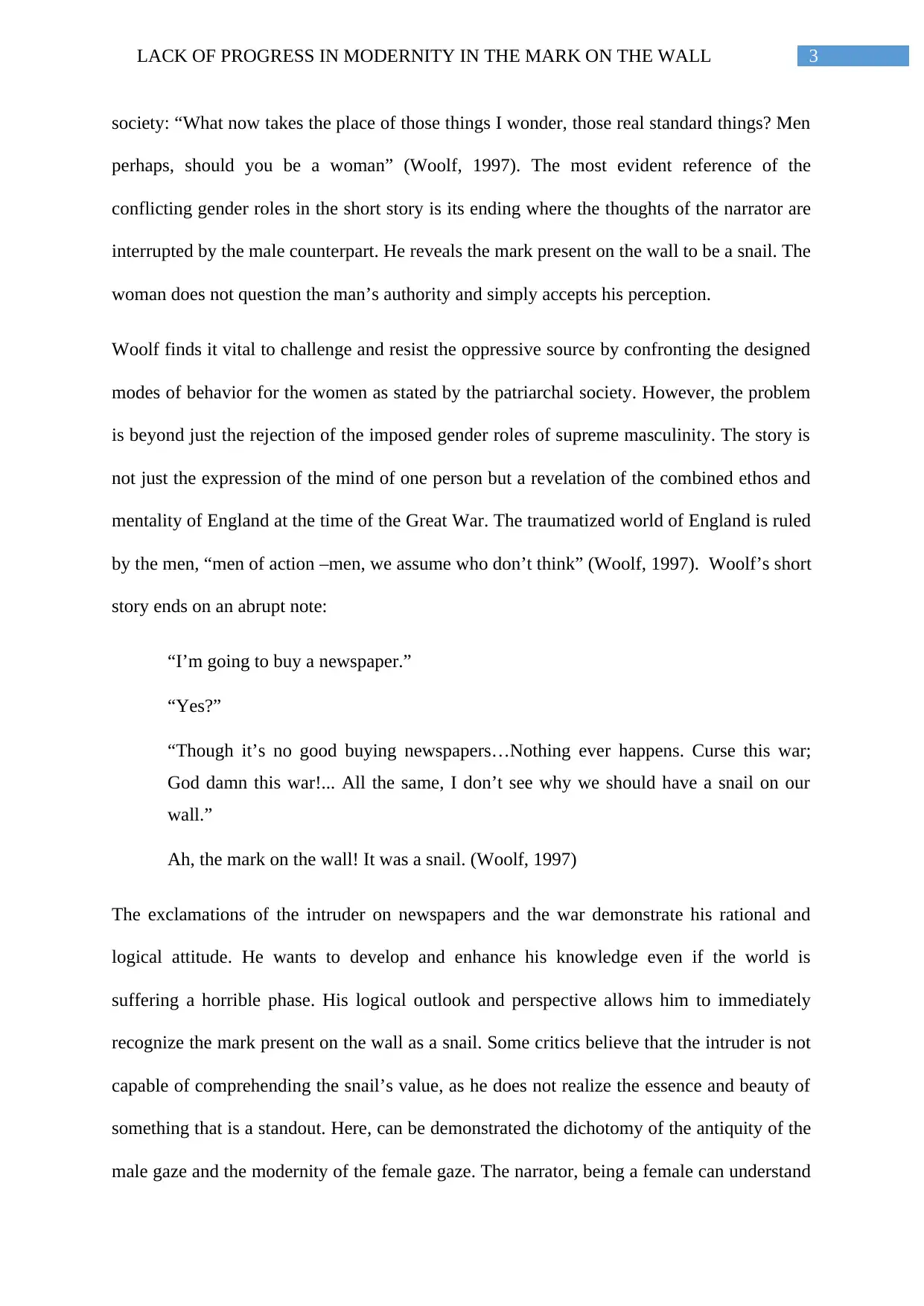
3LACK OF PROGRESS IN MODERNITY IN THE MARK ON THE WALL
society: “What now takes the place of those things I wonder, those real standard things? Men
perhaps, should you be a woman” (Woolf, 1997). The most evident reference of the
conflicting gender roles in the short story is its ending where the thoughts of the narrator are
interrupted by the male counterpart. He reveals the mark present on the wall to be a snail. The
woman does not question the man’s authority and simply accepts his perception.
Woolf finds it vital to challenge and resist the oppressive source by confronting the designed
modes of behavior for the women as stated by the patriarchal society. However, the problem
is beyond just the rejection of the imposed gender roles of supreme masculinity. The story is
not just the expression of the mind of one person but a revelation of the combined ethos and
mentality of England at the time of the Great War. The traumatized world of England is ruled
by the men, “men of action –men, we assume who don’t think” (Woolf, 1997). Woolf’s short
story ends on an abrupt note:
“I’m going to buy a newspaper.”
“Yes?”
“Though it’s no good buying newspapers…Nothing ever happens. Curse this war;
God damn this war!... All the same, I don’t see why we should have a snail on our
wall.”
Ah, the mark on the wall! It was a snail. (Woolf, 1997)
The exclamations of the intruder on newspapers and the war demonstrate his rational and
logical attitude. He wants to develop and enhance his knowledge even if the world is
suffering a horrible phase. His logical outlook and perspective allows him to immediately
recognize the mark present on the wall as a snail. Some critics believe that the intruder is not
capable of comprehending the snail’s value, as he does not realize the essence and beauty of
something that is a standout. Here, can be demonstrated the dichotomy of the antiquity of the
male gaze and the modernity of the female gaze. The narrator, being a female can understand
society: “What now takes the place of those things I wonder, those real standard things? Men
perhaps, should you be a woman” (Woolf, 1997). The most evident reference of the
conflicting gender roles in the short story is its ending where the thoughts of the narrator are
interrupted by the male counterpart. He reveals the mark present on the wall to be a snail. The
woman does not question the man’s authority and simply accepts his perception.
Woolf finds it vital to challenge and resist the oppressive source by confronting the designed
modes of behavior for the women as stated by the patriarchal society. However, the problem
is beyond just the rejection of the imposed gender roles of supreme masculinity. The story is
not just the expression of the mind of one person but a revelation of the combined ethos and
mentality of England at the time of the Great War. The traumatized world of England is ruled
by the men, “men of action –men, we assume who don’t think” (Woolf, 1997). Woolf’s short
story ends on an abrupt note:
“I’m going to buy a newspaper.”
“Yes?”
“Though it’s no good buying newspapers…Nothing ever happens. Curse this war;
God damn this war!... All the same, I don’t see why we should have a snail on our
wall.”
Ah, the mark on the wall! It was a snail. (Woolf, 1997)
The exclamations of the intruder on newspapers and the war demonstrate his rational and
logical attitude. He wants to develop and enhance his knowledge even if the world is
suffering a horrible phase. His logical outlook and perspective allows him to immediately
recognize the mark present on the wall as a snail. Some critics believe that the intruder is not
capable of comprehending the snail’s value, as he does not realize the essence and beauty of
something that is a standout. Here, can be demonstrated the dichotomy of the antiquity of the
male gaze and the modernity of the female gaze. The narrator, being a female can understand
Paraphrase This Document
Need a fresh take? Get an instant paraphrase of this document with our AI Paraphraser
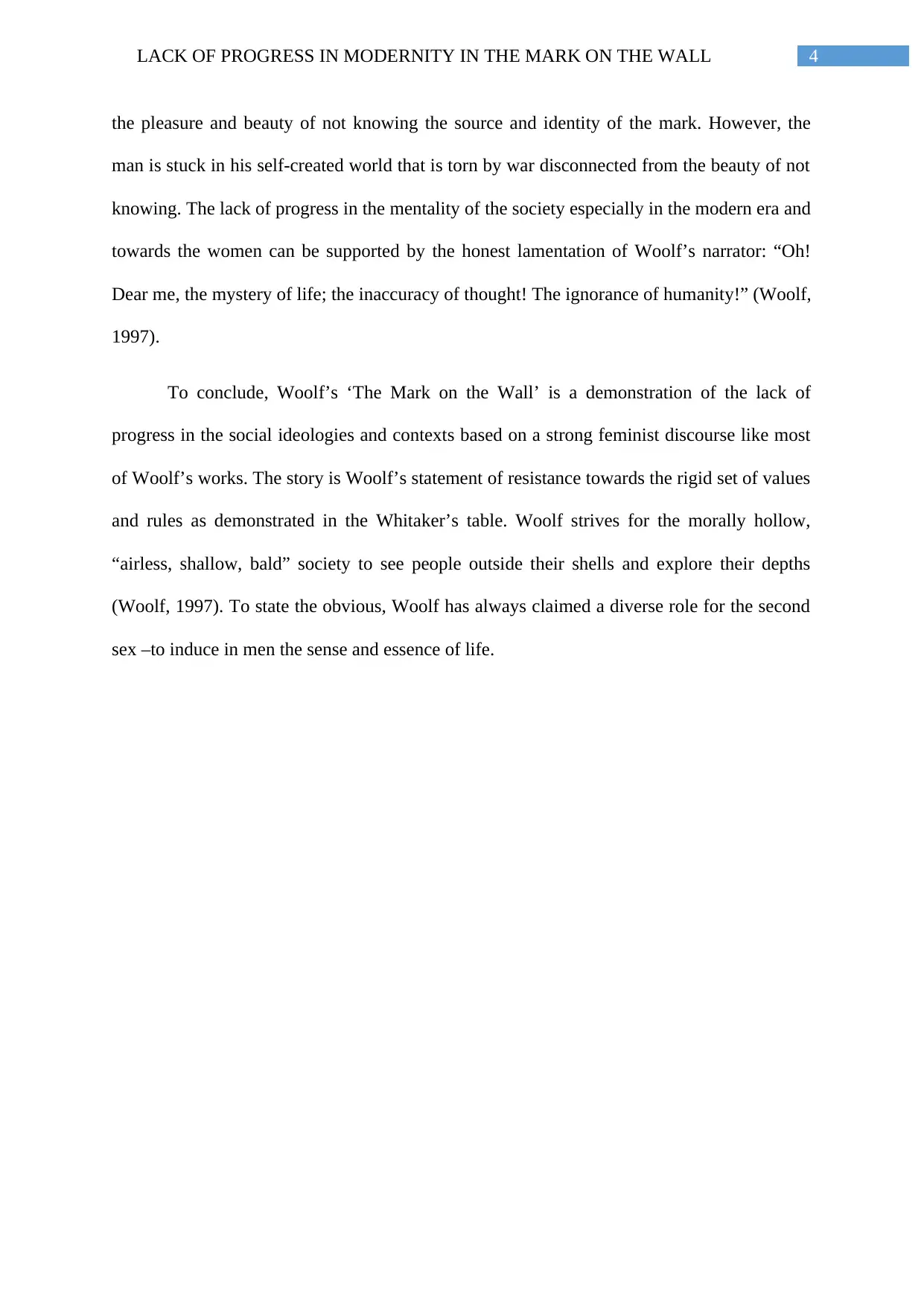
4LACK OF PROGRESS IN MODERNITY IN THE MARK ON THE WALL
the pleasure and beauty of not knowing the source and identity of the mark. However, the
man is stuck in his self-created world that is torn by war disconnected from the beauty of not
knowing. The lack of progress in the mentality of the society especially in the modern era and
towards the women can be supported by the honest lamentation of Woolf’s narrator: “Oh!
Dear me, the mystery of life; the inaccuracy of thought! The ignorance of humanity!” (Woolf,
1997).
To conclude, Woolf’s ‘The Mark on the Wall’ is a demonstration of the lack of
progress in the social ideologies and contexts based on a strong feminist discourse like most
of Woolf’s works. The story is Woolf’s statement of resistance towards the rigid set of values
and rules as demonstrated in the Whitaker’s table. Woolf strives for the morally hollow,
“airless, shallow, bald” society to see people outside their shells and explore their depths
(Woolf, 1997). To state the obvious, Woolf has always claimed a diverse role for the second
sex –to induce in men the sense and essence of life.
the pleasure and beauty of not knowing the source and identity of the mark. However, the
man is stuck in his self-created world that is torn by war disconnected from the beauty of not
knowing. The lack of progress in the mentality of the society especially in the modern era and
towards the women can be supported by the honest lamentation of Woolf’s narrator: “Oh!
Dear me, the mystery of life; the inaccuracy of thought! The ignorance of humanity!” (Woolf,
1997).
To conclude, Woolf’s ‘The Mark on the Wall’ is a demonstration of the lack of
progress in the social ideologies and contexts based on a strong feminist discourse like most
of Woolf’s works. The story is Woolf’s statement of resistance towards the rigid set of values
and rules as demonstrated in the Whitaker’s table. Woolf strives for the morally hollow,
“airless, shallow, bald” society to see people outside their shells and explore their depths
(Woolf, 1997). To state the obvious, Woolf has always claimed a diverse role for the second
sex –to induce in men the sense and essence of life.
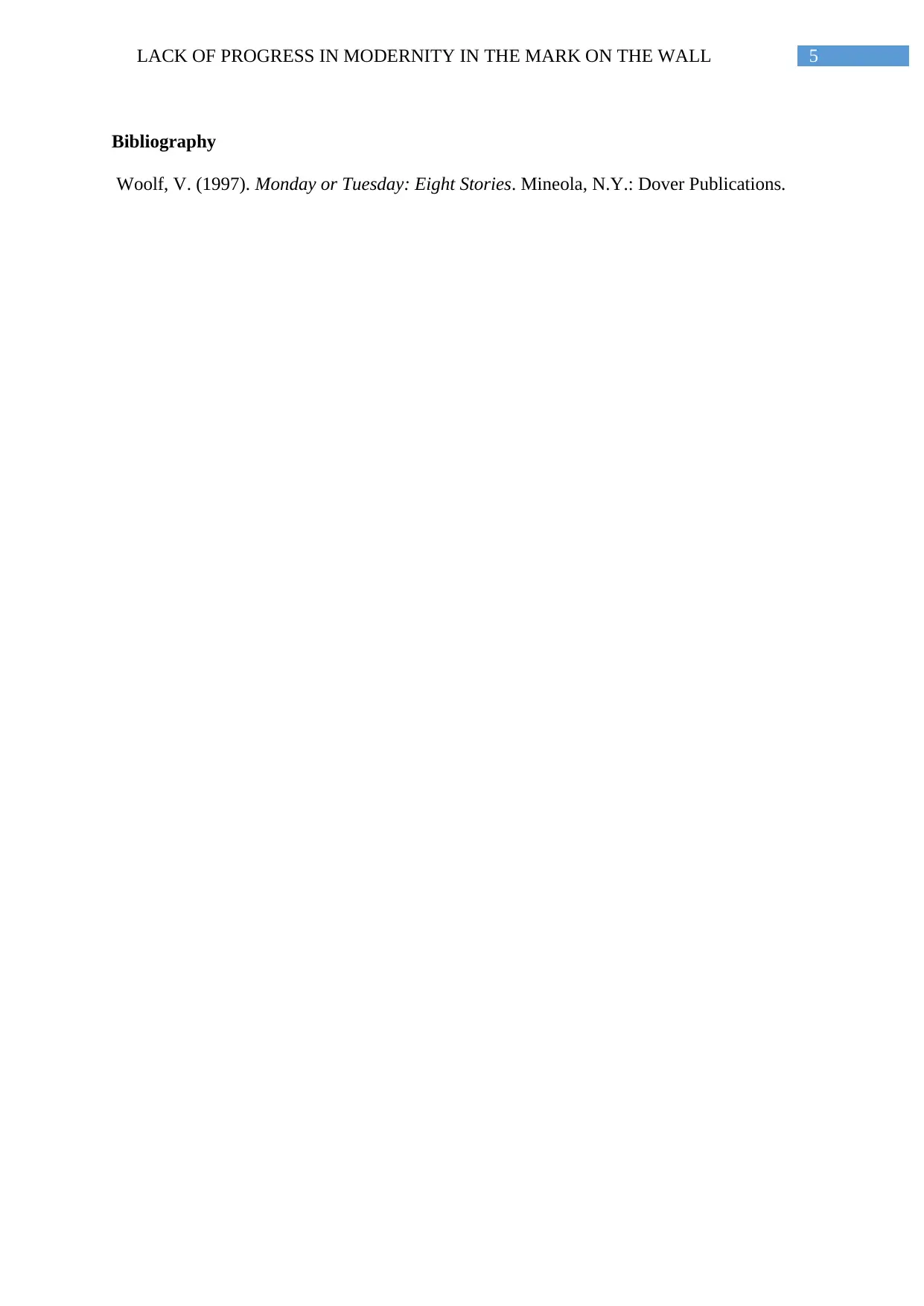
5LACK OF PROGRESS IN MODERNITY IN THE MARK ON THE WALL
Bibliography
Woolf, V. (1997). Monday or Tuesday: Eight Stories. Mineola, N.Y.: Dover Publications.
Bibliography
Woolf, V. (1997). Monday or Tuesday: Eight Stories. Mineola, N.Y.: Dover Publications.
⊘ This is a preview!⊘
Do you want full access?
Subscribe today to unlock all pages.

Trusted by 1+ million students worldwide
1 out of 6
Related Documents
Your All-in-One AI-Powered Toolkit for Academic Success.
+13062052269
info@desklib.com
Available 24*7 on WhatsApp / Email
![[object Object]](/_next/static/media/star-bottom.7253800d.svg)
Unlock your academic potential
Copyright © 2020–2025 A2Z Services. All Rights Reserved. Developed and managed by ZUCOL.



